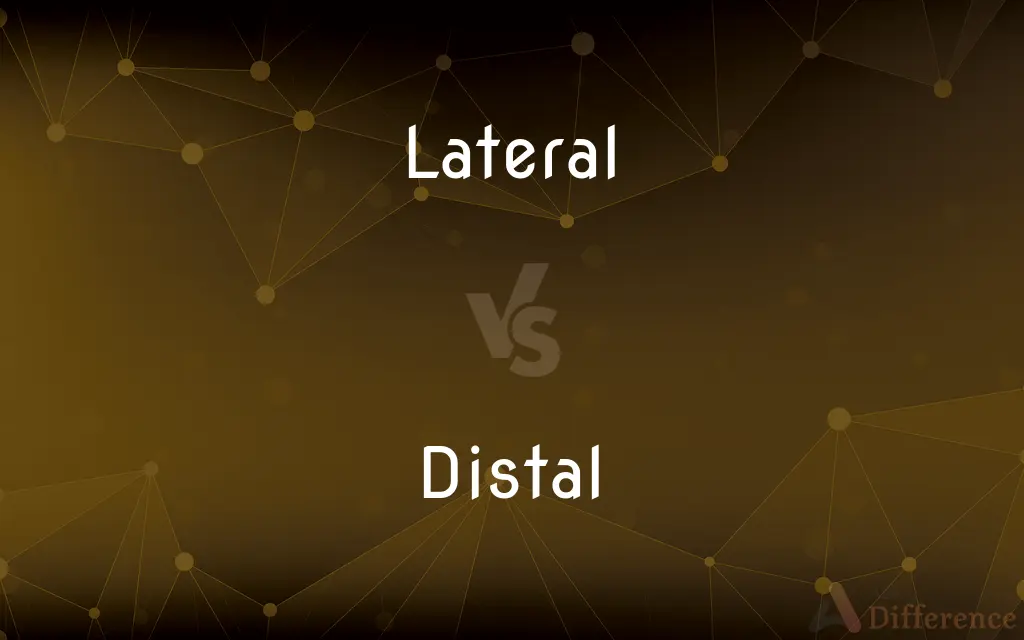Lateral vs. Distal — What's the Difference?
By Fiza Rafique & Maham Liaqat — Updated on May 7, 2024
Lateral refers to a position away from the midline of the body, whereas distal indicates a point further from the trunk or point of origin.

Difference Between Lateral and Distal
Table of Contents
ADVERTISEMENT
Key Differences
Lateral describes a direction or position that is away from the body's midline, while distal refers to a point farther away from the center of the body or point of attachment.
Lateral positions are relative to the body's midline, so the left ear is lateral to the nose, whereas distal locations are relative to an attachment point, such as the wrist being distal to the elbow.
Lateral typically compares structures side-by-side across the body's width, whereas distal often relates to structures along limbs, comparing how far they are from the torso.
Lateral orientation helps describe anatomical features like the lateral sides of the brain or lungs, whereas distal positioning clarifies how far a body part is located along a limb or structure.
Lateral terminology is also used in biology and other sciences, while distal is more specifically applied in anatomical contexts involving extremities or structures originating from a central point.
ADVERTISEMENT
Comparison Chart
Definition
Position away from the midline
Position away from the point of origin
Usage
Compares structures across body width
Compares structures along a limb
Example
Ears are lateral to the eyes
Fingers are distal to the wrist
Orientation
Relative to midline
Relative to a point of attachment
Application Context
Anatomy, biology, geography
Anatomy, especially limbs
Compare with Definitions
Lateral
Situated away from the body's midline.
The lateral side of the thigh is farthest from the groin.
Distal
Situated farthest from the center or point of attachment.
The fingers are distal to the wrist.
Lateral
Relating to the sides rather than the center.
The lateral lobes of the brain are responsible for sensory processing.
Distal
Further from the point of origin in structures.
Distal nerve damage affected the hand.
Lateral
Directed toward the side.
She took a lateral step to dodge the obstacle.
Distal
Anatomically remote from a specific location.
The foot is distal to the knee.
Lateral
Growing or extending to the side.
Lateral branches spread from the trunk of the tree.
Distal
Distant from the body or trunk.
The distal part of the limb is most susceptible to injury.
Lateral
Moving sideways.
The athlete performed a lateral pass to their teammate.
Distal
Related to a part farther along a limb.
The doctor checked the distal pulse of the patient.
Lateral
Of, relating to, or situated at or on the side.
Distal
Situated away from the centre of the body or from the point of attachment
The distal end of the tibia
Lateral
Of or constituting a change within an organization or hierarchy to a position at a similar level, as in salary or responsibility, to the one being left
Made a lateral move within the company.
Distal
Anatomically located far from a point of reference, such as an origin or a point of attachment.
Lateral
(Linguistics) Of, relating to, or being a sound produced by breath passing along one or both sides of the tongue.
Distal
Situated farthest from the middle and front of the jaw, as a tooth or tooth surface.
Lateral
A lateral part, projection, passage, or appendage.
Distal
Remote from the point of attachment or origin.
The distal end of a bone or muscle
Lateral
(Football) A lateral pass.
Distal
(dentistry) Facing the wisdom tooth or temporomandibular joint on the same side of the jaw.
Lateral
(Linguistics) A lateral sound, such as (l).
Distal
(linguistics) Far or farther from the speaker.
Lateral
To execute a lateral pass.
Distal
Remote from the point of attachment or origin; as, the distal end of a bone or muscle
Lateral
To pass (the ball) sideways or backward.
Distal
Situated farthest from point of attachment or origin, as of a limb or bone
Lateral
To the side; of or pertaining to the side.
Instead of a promotion, I opted for a lateral move to a similar position in the marketing department.
Distal
Directed away from the midline or mesial plane of the body
Lateral
Situated on one side or other of the body or of an organ, especially in the region furthest from the median plane.
The medial side of the knee faces the other knee, while the outer side of the knee is lateral.
A fish senses changes in hydrodynamic pressure with its lateral line.
Lateral
(disease) Affecting the side or sides of the body, or confined to one side of the body.
Lateral
(physics) Acting or placed at right angles to a line of motion or strain.
Lateral
(UK) Non-linear or unconventional, as in, lateral thinking.
Lateral
Pertaining to speech sounds generated by partially blocking the egress of the airstream with the tongue, leaving space on one or both sides of the occlusion for air passage.
Lateral
An object, such as a passage or a protrusion, that is situated on the side of something else.
Lateral
(linguistics) A sound produced through lateral pronunciation (such as /l/ in lateral).
Lateral
(American football) A lateral pass.
Lateral
(business) An employee hired for a position at the same organizational level or salary as their previous position.
Lateral
To move (oneself or something) in a lateral direction.
Lateral
(American football) To execute a lateral pass.
Lateral
Of or pertaining to the sides; as, the lateral walls of a house; the lateral branches of a tree.
Lateral
Lying at, or extending toward, the side; away from the mesial plane; external; - opposed to mesial.
Lateral
Directed to the side; as, a lateral view of a thing.
Lateral
A short pass to a receiver who is upfield from the passer, i.e. is behind the passer relative to the direction of the passer's goal.
Lateral
A part or extension of something that points sideways, as a drift in a mine that goes to the side from the main one.
Lateral
To pass the footbal to a receiver who is behind the passer; to make a lateral pass; as, the ball was lateraled to the fullback, who ran it for a touchdown.
Lateral
A pass to a receiver upfield from the passer
Lateral
Situated at or extending to the side;
The lateral branches of a tree
Shot out sidelong boughs
Lateral
Lying away from the median and sagittal plane of a body;
Lateral lemniscus
Common Curiosities
How does distal relate to limbs?
It indicates a position further from the body's trunk or point of attachment.
What does lateral mean?
It refers to a position or direction away from the body's midline.
What is an example of a lateral body part?
The ears are lateral to the eyes.
Is distal always related to limbs?
Mostly, but it can also refer to other structures originating from a central point.
What is the opposite of distal?
Proximal, meaning closer to the trunk or point of origin.
Is the elbow distal to the shoulder?
Yes, the elbow is distal to the shoulder.
Is lateral used only in anatomy?
No, it's also used in other sciences to describe sideward orientations.
Is the heart lateral to the lungs?
No, the heart is medial (closer to the midline) compared to the lungs.
Can lateral refer to the entire body?
Yes, it describes any structure positioned sideways from the midline.
Is the wrist distal or lateral to the shoulder?
The wrist is distal to the shoulder.
Can distal refer to parts other than limbs?
Yes, such as nerves extending from a central location.
How do proximal and distal compare to medial and lateral?
Proximal and distal describe distance from the body's point of attachment, while medial and lateral describe distance from the body's midline.
What structures are considered lateral to the brain's midline?
The cerebral hemispheres are lateral to the brain's midline.
Are lateral movements side-to-side?
Yes, lateral movements refer to actions directed toward the sides.
What is an example of a distal joint?
The knee is a distal joint relative to the hip.
Share Your Discovery

Previous Comparison
Realist vs. Pragmatist
Next Comparison
Wizard vs. EnchanterAuthor Spotlight
Written by
Fiza RafiqueFiza Rafique is a skilled content writer at AskDifference.com, where she meticulously refines and enhances written pieces. Drawing from her vast editorial expertise, Fiza ensures clarity, accuracy, and precision in every article. Passionate about language, she continually seeks to elevate the quality of content for readers worldwide.
Co-written by
Maham Liaqat















































